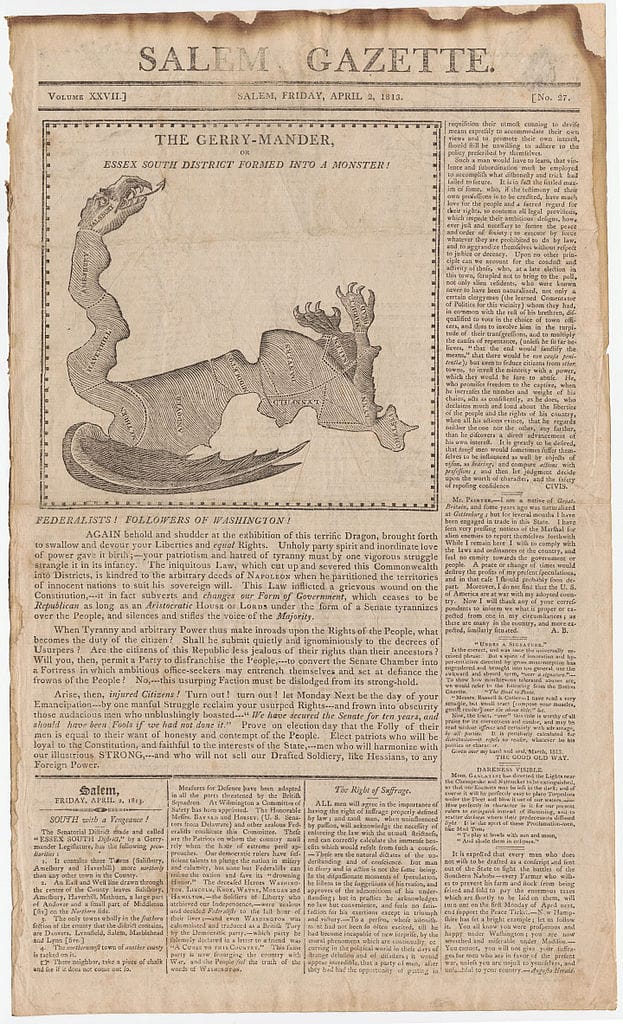Let’s Not Forget About the Other Threat to Democracy: The Gerrymander
Ninety-five percent of the 4 million newcomers to Texas are people of color, half of whom identify as Latino. Yet, the growing number of people of color in Texas is not growing in their ability to choose who represents them.

IMHO, there are too many legal opportunities or legally vulnerable ways to undermine our democratic system of government. The good news is efforts to sabotage our rights that flew under our radars decades ago, are outed today thanks to information accessibility. But the bad news is they’re not slapped down hard enough.
Of all the sleazy practices and underhanded tricks to silence targeted voices, gerrymandering must be among the snake-bellied, lowest. This voting-rights-hater practice needs either a do-over or an ‘it’s over.’
My wild imagination personified this voter sin into the crafty, villain Gerry Mander. A Snidely Whiplash of today who wears dark suits and is hell-bent on attacking women and their freedom. (For those too young to know, Snidely Whiplash was the stereotypical villain in the Dudley Do-right cartoons). But Gerry Mander is far more dangerous.
Who Created This Beast?
Like everything, gerrymandering has an origin. The term is a portmanteau of the name of Former Vice President/Former Massachusetts Governor, Elbridge Gerry, and a salamander. In 1812, Governor Gerry signed a bill that created a partisan district in Boston shaped like a salamander. A political cartoonist at the time created an image for the process, a winged animal as the gerrymander.

A wrong turn from re-apportionment to reflect post-census districts, gerrymandering is political manipulation to create districts that either expand representation or undermine it. Gerrymandering to dilute voting power is called cracking. Gerrymandering to concentrate voting power is known as packing. Euphemisms aside, gerrymandering in the wrong hands destroys the two-party system of government and prevents marginalized people from having a voice in their representation. We could call it, stacking the deck in your party’s favor every 10 years following the census.

Texas Tops the List of Political Lizardry
The non-partisan law and policy institute, The Brennan Center for Justice called out Texas for crafting “one of the most politically and racially skewed maps of this (2021) redistricting cycle.
In their article, Anatomy of the Texas Gerrymander they wrote, “When Texas Republicans redrew their state’s congressional map earlier this year, they took what had been one of the most competitive and politically interesting maps in the country and, through discrimination against fast-growing racial and ethnic minorities, transformed it into one of the most boring and least dynamic.” I will add, and the most racist.
Remember sharing candy as kids? The one-for-you, two-for-me method of distribution? That’s how Texas lawmakers have re-drawn districts. But a post-2011 two-fer backfired in central Texas. The GOP strategy was to divide Austin’s Democratic districts to minimize Dem numbers. Once the population in Austin grew larger and more Democrat, Republicans faced that awful reality known as competition. To remedy that, they gave one district to Dems and awarded themselves with multiple, adjacent GOP districts, safe and non-competitive. It had the opposite effect. They employed a new strategy with old targets.
When it comes to people of color, Republicans willingly contradict their own behaviors.
Ninety-five percent of the 4 million newcomers to Texas are people of color, half of whom identify as Latino. This growth earned Texas two additional seats in Congress. The Hispanic population is now nearly equal to the White population in Texas; however, there are twice as many majority White voting districts as Hispanic voting districts. The growing number of people of color in Texas is not growing in their ability to choose who represents them.
Republicans in the Lone Star state not only gift White voters with more opportunities to be heard, but they have also viciously divided Suburban areas with communities of color to ensure the voting impact of non-Whites is weakened. (Not surprising, after all, the governor of Texas is defying a Supreme Court ruling by continuing to use razor wires to prevent men, women, and children of color from seeking asylum in the state).
Sadly, when it comes to attacking voting rights, half of the states in our country are entwined in legal battles for manipulating voting districts. Most of them are attempts to dilute Black and Latino voting power, others target political parties or both.
These charts from the Brennan Center for Justice show the states currently in litigation and the nature of those lawsuits. The second chart provides a status update.


A gerrymandering case in Alabama made big news recently with a Supreme Court ruling that, frankly, surprised me. The high court agreed with a lower court directing the Alabama legislature to re-draw its new 2022 Republican-drawn congressional map because of “intensely racially polarized voting.” The court said the map would violate section 2 of the Voting Rights Act which prohibits voting practices or procedures that discriminate on the basis of race, color, or membership in one of the language minority groups identified in Section 4(f)(2) of the Act. Alabama’s population is 27% Black, but their representation doesn’t reflect anything near 27%.
When ordered to fix it by adding a second majority Black district, the lawmakers instead increased Black voters in an existing district from 30 to 40 percent. Must be that new math.
In a Texas-esque move, the Alabama legislature has tried delays and outright defiance of both the lower court and the Supreme Court decisions. The lower court saying the state had already conducted a 2022 congressional election with an unlawful map. As you can see from the chart above, this case is ongoing.
Lawsuits…Bigger in Texas
There are consolidated voting rights violation lawsuits in Texas brought by individuals of color, the Texas NAACP, the U.S. Justice Department, and others regarding re-drawn 2021 congressional maps.
As I mentioned earlier, the new maps were obviously drawn for White Republican dominance and not to represent or reflect the population growth which is mostly people of color. The state faces dozens of legal challenges to its congressional and statehouse maps, including allegations of intentional discrimination, vote dilution, and racial gerrymandering. For example, in the Rio Grande Valley and North Texas, Latino and Black voters were intentionally and by design moved into districts where their votes would be diluted.
Dueling Bills in Washington
Last year, Democrats in the U.S. House and the Senate introduced the Freedom to Vote Act to make elections more accessible and safer. Among their proposals, a national election day holiday, and voting protection for those with disabilities and for veterans.
Specifically, the Freedom to Vote Act includes:
- Make November Election Days a public holiday,
- Enact automatic voter registration for each state,
- Require same-day voter registration and early voting periods in each state,
- Restore the right to vote in federal elections for people who have served their time for felony convictions, an end to partisan gerrymandering, and making election interference a criminal offense.
This is in response to the Republican American Confidence in Elections Act. ACE, as it is called, does not prohibit partisan gerrymandering, election interference or anything on the list above. What it does do is make mail-in voting and voter access more challenging. It makes way for voter suppression that negatively impacts/targets, (you guessed it), Black and Latino voters.
Is Gerry Mander is looking more Snidely Whiplash now?
It’s a harsh reality that those of us who value democracy can never tire of fighting the villains who work to undermine it, and the tools and tactics they use, like the gerrymander. Gerrymandering is to voter suppression what Jim Crow was to slavery, different thinly veiled methods toward the same goal: concentrating power to one type of people while harming and disadvantaging all others.
The wickedness attached to efforts that silence the voices of fellow citizens should be criminal in all ways in my opinion. It stands to reason that anyone who is predisposed to take away the rights of others would have no problem taking away freedoms, justice . . . or a life.
